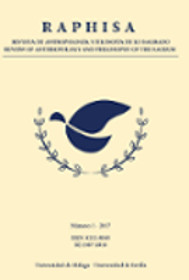The representation of empty space as a return to the origin
An aesthetic approach from daoism
DOI:
https://doi.org/10.24310/Raphisa.2022.v6i2.14661Keywords:
Daoism, Taoism, emptiness, oriental art, Eastern philosophyAbstract
Nothingness and emptiness are concepts that we can recognize as fundamental in Eastern philosophy, however, unlike the conceptions adopted in the West, in ancient Chinese thought –emphasizing Daoism (??)– nothing was not thought as something with an ontological character, but as an indefinable previous state. In a similar way, empty space manifested itself in the arts as the representation of the place where changes and transformations of reality occurred, pointing to the ideal of the artist in allowing himself to flow during the creative process. In this way the absence was made present, approaching the origin of all things.
Downloads
Metrics
References
Chang, Chung-yuan. Creativity and Taoism. A Study of Chinese Philosophy, Art and Poetry. Londres: Singing Dragon, 2011.
Chen, Zhi ??. “Biographical Genres and Biography: The Case of Yan Zun ??”. En China and the World - the World and China: Essays in Honor of Rudolf G. Wagner: Transcultural Perspectives on Modern China (2019), editado por
Barbara Mittler, Joachim Gentz, Natascha Gentz & Catherine Vance Yeh. Ostasien Verlag: Deutsche Ostasienstudien; Vol. 37, No. 1.
Cheng, François. Vacío y plenitud. Madrid: Siruela, 2003.
Costantini, Filippo. El Dao de la sabiduría: Análisis y comparación de los tres comentarios más influyentes del Laozi
Daodejing. Costa Rica: Editorial de la Sede del Pacífico, Universidad de Costa Rica, 2021.
Hay, Jonathan. Shitao. Painting and Modernity in Early Qing China. UK: Cambridge University Press, 2001.
Jullien, François. La gran imagen no tiene forma o del no-objeto por la pintura. Barcelona: Alpha Decay, 2008.
Lao Tse. Tao Te King. Libro del Tao y de su virtud. Versión de Gastón Soublette. Chile: Cuatro Vientos, 1990.
Li, Zehou. The Chinese Aesthetic Tradition. USA: Hawaii University Press, 2010.
Little, Stephen. Taoism and the arts of China. USA: The Art Institute of Chicago, 2001.
Liu, Cary. “The Concept of Space: The Filling of Emptiness in Chinese Architectural Thinking”. En A Companion to
Chinese Art, editado por Martin J. Powers & Katherine R. Tsiang. Wiley-Blackwell, 2016, pp. 195-211.
Liu, Xiaogan. “Laozi’s Philosophy: Textual and Conceptual Analyses”. En Dao Companions to Chinese Philosophy (2015), editado por Xiaogan Liu, Hong Kong: Springer, pp. 71-100.
Pei Di & Wang Wei. Poemas del río Wang. Versos en castellano por Clara Janés. Traducción de Juan Ignacio
Preciado. Madrid: Ediciones del Oriente y del Mediterráneo, 2002.
Platón. Diálogos V. Parménides, Teeteto, Sofista, Político. Traducciones de Ma. Isabel Santa Cruz, Álvaro Vallejo Campos & Néstor Luis Cordero. Madrid: Gredos, 1988.
Terol, Gabriel. “La transición entre los cultos religiosos primitivos de China y el daoismo: la importancia de la alquimia daoísta”. En ’Ilu. Revista de Ciencias de las Religiones, 2011, pp. 259-278.
Zhuangzi. The complete works of Zhuangzi. Traducción de Burton Watson. New York: Columbia University Press, 2013.
Downloads
Published
How to Cite
Issue
Section
License
License permitted by the journal: Public Domain. Authors retain the copyright and full publishing rights without restrictions.






